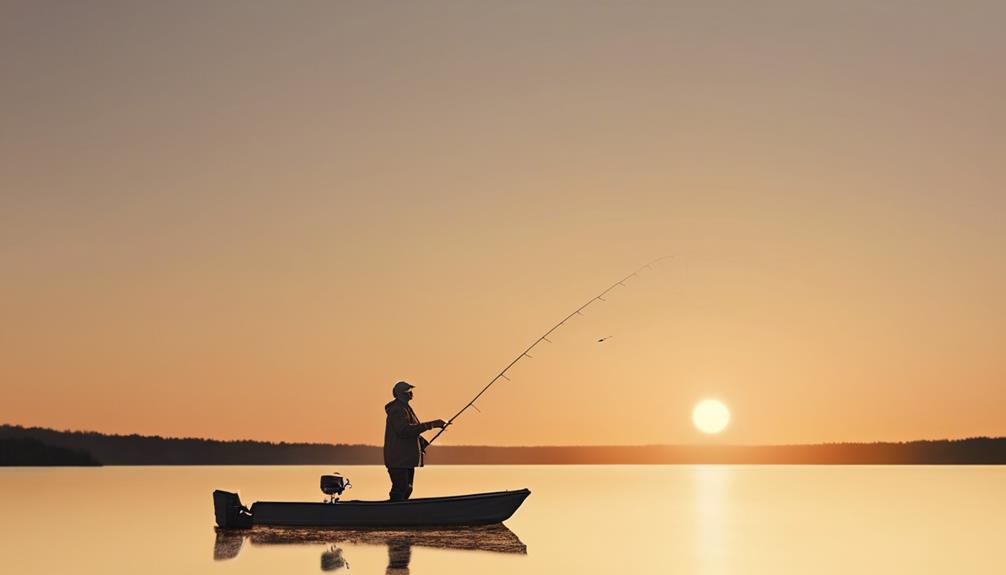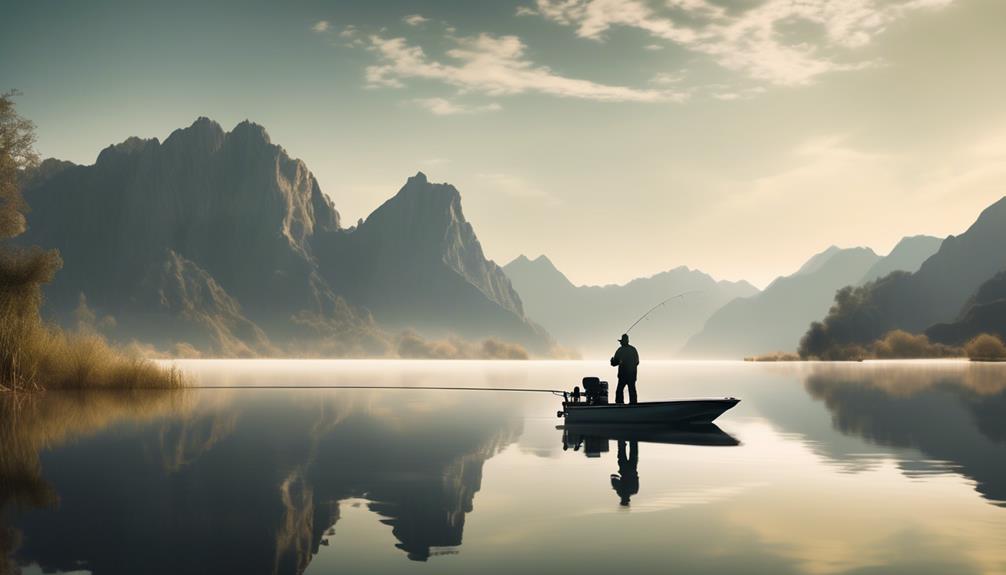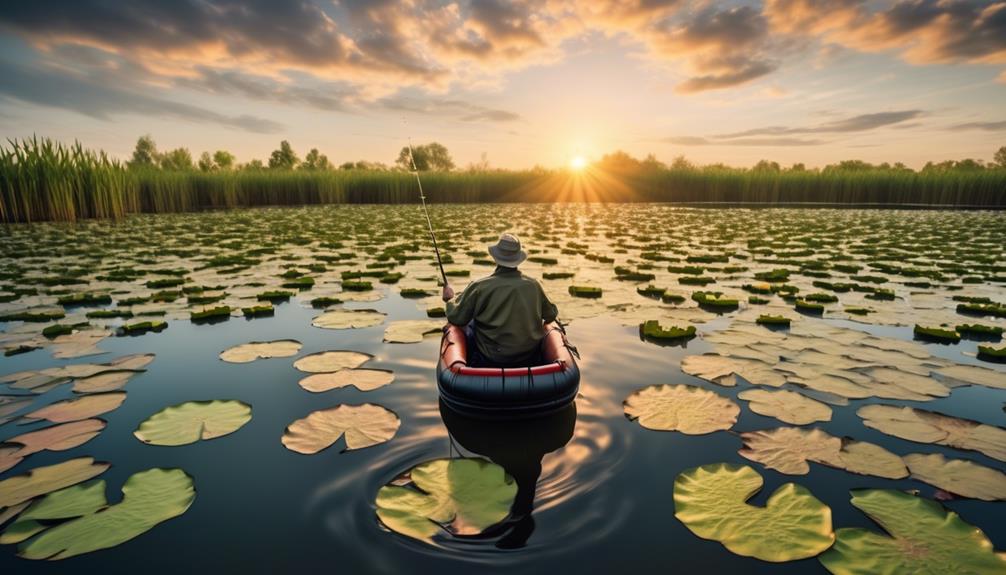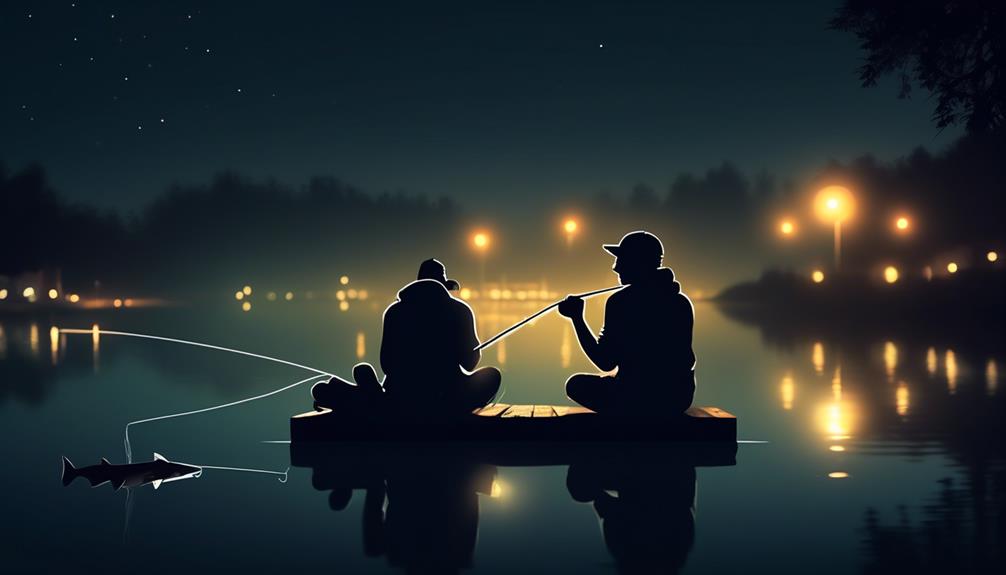So, you're out on the water, hoping to reel in some trophy walleye. You've got your trolling gear ready, but you're not quite sure if you're using the best techniques to attract those elusive walleye.
Well, fear not, because we're about to dive into some expert trolling techniques that will help you up your walleye game. Whether you're a seasoned angler or just starting out, these tips will give you the edge you need to hook into some of the biggest walleye around.
Understanding Walleye Behavior
To successfully catch walleye, it's essential to understand their behavior patterns and feeding habits in different water conditions. Walleye are known for their nocturnal feeding habits, often being more active during low-light conditions, such as early morning or evening. They've excellent low-light vision due to a layer of pigment in their eyes, the tapetum lucidum, which enhances their ability to see in the dark. This makes them more active predators during dawn and dusk, and they tend to retreat to deeper waters during the day. Understanding this behavior can significantly impact your fishing success.
Furthermore, knowing the natural habitats where walleye thrive is crucial. They prefer clear, cool waters and are often found near structures such as rocky points, reefs, or submerged vegetation. These natural habitats provide walleye with ample opportunities to ambush their prey, making these areas prime locations for fishing. During the day, walleye often seek shelter in deeper waters, especially in lakes with significant fluctuations in water temperatures.
Selecting the Right Trolling Speed
Understanding the behavior and natural habitats of walleye, you can now focus on selecting the right trolling speed to effectively target these elusive fish. Trolling speed variation is crucial when it comes to walleye fishing. The optimal speed can vary depending on the time of year, water temperature, and the walleye's feeding patterns. In general, a speed range of 1.5 to 3 miles per hour is a good starting point, but it's important to be open to adjusting this based on the conditions you encounter.
When it comes to speed adjustment, water conditions play a significant role. In colder water, walleye tend to be more sluggish, so slowing down your trolling speed within the lower end of the range can be beneficial. Conversely, in warmer water, walleye are typically more active, so increasing your speed towards the upper end of the range may yield better results.
Additionally, factors such as wind and current can also impact the ideal trolling speed. When trolling against a strong current, you may need to increase your speed to maintain lure depth and action, while trolling with the current might require a slight decrease in speed to avoid moving too quickly past the fish-holding areas.
Using Inline Planer Boards
Consider using inline planer boards to effectively spread out your trolling lines and cover a wider area of water when targeting walleye. Board positioning is crucial when using inline planer boards for trolling.
To maximize coverage, position the boards as far away from the boat as possible without tangling lines. By doing so, you can effectively cover a larger area and increase your chances of encountering walleye.
When using this trolling technique, it's important to employ inline planer tactics for optimal success. One effective tactic is to stagger the distance of the planer boards from the boat. This helps prevent tangles and allows for a wider spread of lures, increasing the likelihood of attracting walleye.
Additionally, adjusting the positioning of the planer boards in relation to the water conditions can make a significant difference. For instance, in choppy waters, positioning the planer boards closer to the boat can help maintain better control of the lines.
Incorporating inline planer boards into your trolling strategy can greatly enhance your chances of success when targeting walleye. By mastering board positioning and employing effective inline planer tactics, you can cover more water and increase the likelihood of enticing walleye to take the bait.
Choosing the Best Lures for Walleye
When targeting walleye using inline planer boards, the choice of lures is crucial for maximizing your chances of success. Here are some key factors to consider when choosing the best lures for walleye:
- Lure Color
- The color of the lure can significantly impact your success when trolling for walleye. In clear water, natural colors like silver, white, and light green can be effective, while in murky or stained water, bright and contrasting colors such as chartreuse, orange, and pink may be more visible to walleye. It's essential to have a variety of colors in your tackle box to adapt to different water conditions and light levels throughout the day.
- Lure Size
- The size of the lure can also make a difference in enticing walleye to strike. When trolling, it's beneficial to have a selection of lures in varying sizes to test what the walleye are responding to on any given day. In general, smaller lures in the 1/8 to 1/4 ounce range are suitable for walleye, but larger lures may be necessary in certain situations, especially when targeting larger fish.
- Additional Considerations
- Apart from color and size, factors such as lure action, diving depth, and rattling noise can also influence the effectiveness of the lure. Experiment with different combinations to find the optimal lure for the specific conditions you're fishing in.
Mastering Depth Control
To master depth control when trolling for walleye, focus on adjusting your trolling speed and using the appropriate equipment to achieve the desired depth for optimal fishing success. Depth adjustment is crucial when targeting walleye, as they're often found at specific depths depending on factors such as water temperature, time of day, and light conditions.
One effective method for achieving precision trolling is by using tools such as a line counter reel, which allows you to accurately measure the amount of line you have let out. This is essential for replicating successful trolling passes at the same depth.
Another key aspect of depth control is the use of diving planers or downriggers. Diving planers can be attached to your line and will dive to a predetermined depth, allowing you to cover a larger area of water at the desired depth. Downriggers are also valuable tools for maintaining depth control, as they allow you to precisely set the depth at which your bait or lure is presented to the fish.
By incorporating these tools into your trolling setup, you can effectively target walleye at their preferred depths, increasing your chances of a successful catch.
It's important to remember that walleye can be quite selective about the depth at which they feed, so mastering depth control through precise trolling techniques can make a significant difference in your fishing results. By paying close attention to depth adjustment and utilizing the appropriate equipment, you can enhance your trolling fishing techniques for walleye and improve your overall success on the water.
Harnessing the Power of Downriggers
Mastering depth control when trolling for walleye can maximize fishing success. Effectively harnessing the power of downriggers is key to presenting bait or lure at the desired depth. Here's how to make the most of your downriggers:
- Downrigger Setup:
- Attach the downrigger weight to the cannonball.
- Connect the release clip to the fishing line.
- Adjust depth settings based on walleye location.
- Ensure downrigger cable is properly spooled and not tangled.
- Utilize a fish finder to determine walleye depth.
- Set downriggers to these depths for optimal results.
- Downrigger Maintenance:
- Regular maintenance is crucial for efficient functioning.
- Lubricate moving parts to prevent rust and corrosion.
- Check cables for wear and tear, replace if necessary.
- Keep downrigger mounts clean and free of debris.
- Inspect electrical components for faults.
- Proper maintenance extends lifespan and ensures top working condition.
Perfecting Trolling Patterns

Maximize your walleye trolling success by honing your ability to create and maintain effective trolling patterns. Achieving the perfect trolling pattern requires mastering boat control and understanding the importance of using a line counter to precisely measure the length of line being released behind the boat.
Boat control is essential for maintaining the desired trolling speed and direction, which directly impacts the effectiveness of your trolling pattern. To maintain a consistent pattern, it's crucial to make precise adjustments to your boat's speed and direction, keeping the lures in the strike zone for walleye.
Using a line counter allows you to replicate successful patterns by precisely measuring the amount of line released when you get a strike.
When perfecting trolling patterns, it's important to understand how different factors such as water depth, structure, and the behavior of walleye can influence your approach. Adjusting your trolling pattern based on these factors can significantly increase your chances of a successful catch.
Experiment with different trolling speeds, depths, and lure presentations to find the most effective pattern for the conditions you're facing. Keep detailed records of your successful patterns, including the amount of line released and the boat speed, to replicate them in similar conditions.
Fine-Tuning Your Presentation
Honing your presentation skills is crucial for fine-tuning your trolling fishing technique for walleye. To maximize your chances of a successful catch, consider the following tips:
- Bait Selection: Choosing the right bait is essential for enticing walleye. Experiment with different types of live bait, such as minnows, leeches, or nightcrawlers, to see which option the walleye in your area prefer. Additionally, using artificial lures like crankbaits or spinner rigs can also be effective, especially in varying water conditions. Pay attention to the color, size, and action of your bait to match the prevailing conditions and the walleye's preferences.
- Boat Control: Maintaining precise boat control is vital when trolling for walleye. Utilize technologies such as GPS trolling motors to maintain a consistent speed and direction, allowing you to cover more water effectively. Adjust your trolling speed based on the walleye's activity level and the water temperature. Additionally, consider using planer boards to spread out your lines and cover a wider area, increasing the chances of attracting walleye.
- Presentation Consistency: Once you've found a successful bait and trolling speed, it's crucial to maintain a consistent presentation. Keep an eye on your rod tips for any signs of strikes or changes in the bait's action. Vary your lure's depth and distance from the boat to determine the walleye's preferred strike zone.
Frequently Asked Questions
What Are the Best Times of Day to Troll for Walleye?
For the best times of day to troll for walleye, focus on using the best bait and maintaining an optimal speed. Early morning and late evening are prime times, as walleye are more active during low light conditions.
How Do Weather Conditions Affect Walleye Trolling Techniques?
When trolling for walleye, weather conditions play a crucial role. The moon phase impacts walleye activity, so pay attention to it. Also, water temperature affects their behavior, so adjust your trolling techniques accordingly for better results.
Are There Any Specific Trolling Techniques for Targeting Trophy-Sized Walleye?
To target trophy-sized walleye while trolling, focus on bait selection for their preferences and depth control. Experiment with different lures and adjust your trolling speed and depth until you find the right combination for catching those big walleye.
Can You Provide Tips for Trolling in Different Types of Water Bodies, Such as Rivers or Lakes?
When trolling in different water bodies like rivers or lakes, adjust your trolling speed and depth based on the walleye's location. Vary lure selection and presentation to mimic natural prey. This flexibility increases your chances of a successful catch.
What Are Some Common Mistakes to Avoid When Trolling for Walleye?
When trolling for walleye, common mistakes to avoid include inconsistent trolling speed, neglecting equipment maintenance, and using the wrong bait. Maintaining a steady speed, keeping gear in top shape, and selecting the right bait are crucial for success.
Conclusion
So, now that you've learned the best trolling fishing techniques for walleye, it's time to get out on the water and put your new skills to the test.
Remember to pay attention to walleye behavior, use the right trolling speed, and select the best lures.
Master depth control, utilize downriggers, and perfect your trolling patterns.
With practice and patience, you'll be reeling in those walleye in no time!



